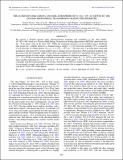THE ACCRETION DISK CORONA AND DISK ATMOSPHERE OF 4U 1624–490 AS VIEWED BY THE CHANDRA-HIGH ENERGY TRANSMISSION GRATING SPECTROMETER
Author(s)
Xiang, Jingen; Lee, Julia C.; Nowak, Michael A.; Wilms, Jörn; Schulz, Norbert S.
DownloadXiang-2009-THE ACCRETION DISK C.pdf (560.6Kb)
PUBLISHER_POLICY
Publisher Policy
Article is made available in accordance with the publisher's policy and may be subject to US copyright law. Please refer to the publisher's site for terms of use.
Terms of use
Metadata
Show full item recordAbstract
We present a detailed spectral study (photoionization modeling and variability) of the "Big Dipper" 4U 1624–490 based on a Chandra-High Energy Transmission Grating Spectrometer (HETGS) observation over the ~76 ks binary orbit of 4U 1624–490 . While the continuum spectrum can be modeled using a blackbody plus power law, a slightly better fit is obtained using a single Γ = 2.25 power-law partially (71%) covered by a local absorber of column density [superscript N]H, Local = 8.1 [+0.7/-0.6] x 10[superscript 22]cm[superscript -2]. The data show a possible quasi-sinusoidal modulation with period 43[superscript +13][subscript –9] ks that might be due to changes in local obscuration. Photoionization modeling with the XSTAR code and variability studies of the observed strong Fe XXV and Fe XXVI absorption lines point to a two-temperature plasma for their origin: a highly ionized component of ionization parameter ξhot ≈ 10[superscript 4.3] erg cm s[superscript -1] (T ~ 3.0 × 10[superscript 6] K) associated with an extended accretion disk corona of radius R ~ 3 × 10[superscript 10] cm, and a less-ionized more variable component of ξ ≈ 103.4 erg cm s-1 (T ~ 1.0 × 106 K) and ξ ≈ 10[superscript 3.1] erg cm s[superscript -1] (T ~ 0.9 × 106 K) coincident with the accretion disk rim. We use this, with the observed Fe XXV and Fe XXVI absorption line variations (in wavelength, strength, and width) to construct a viewing geometry that is mapped to changes in plasma conditions over the 4U 1624–490 orbital period.
Date issued
2009-08Department
MIT Kavli Institute for Astrophysics and Space ResearchJournal
Astrophysical Journal
Publisher
Institute of Physics/American Astronomical Society
Citation
Xiang, Jingen, Julia C. Lee, Michael A. Nowak, Jörn Wilms, and Norbert S. Schulz. “ THE ACCRETION DISK CORONA AND DISK ATMOSPHERE OF 4U 1624–490 AS VIEWED BY THE CHANDRA -HIGH ENERGY TRANSMISSION GRATING SPECTROMETER .” The Astrophysical Journal 701, no. 2 (July 29, 2009): 984–993. © 2009 American Astronomical Society.
Version: Final published version
ISSN
0004-637X
1538-4357